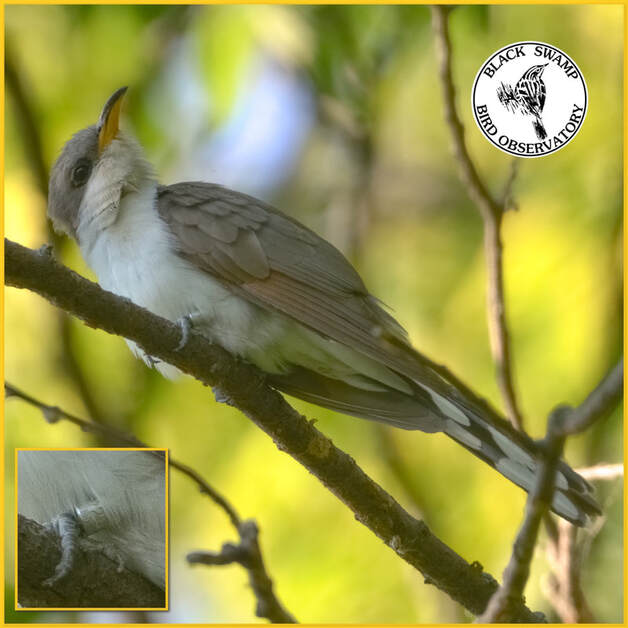Enjoying our blogs?Your support helps BSBO continue to develop and deliver educational content throughout the year.
|
|
After photographing this Yellow-billed Cuckoo (YBCU) for nearly half an hour, I was flabbergasted when I pulled up the photos on my computer and realized this bird was BANDED! In over 200 photos of this bird, the band showed for only a brief few seconds during the photoshoot owing to short legs and a cuckoo’s propensity for lounging low on a branch. While we’ll almost certainly never be able to read the band number well enough to determine which individual bird this is, the most likely explanation is that this is a locally-breeding, adult YBCU banded by BSBO in a previous year.
There are a few pieces of information that help us reach this conclusion. First, we know that BSBO did not band this bird in 2020, since we haven’t banded any YBCU this year, so if this bird was banded by us, it didn’t happen this year. Second, when we look closely at the band, we can see that the edges have been worn smooth and round, a phenomenon that only happens after (typically) years of wear on a band. This bird was definitely not banded any time recently. So we’re left with two explanations. Option a.) this bird was banded by BSBO in a previous year, or b.) this bird was banded by another bander/banding station in a previous year. In order to parse those options a bit further we need to consider recapture likelihood. “Foreign recapture,” a bird recaptured in a location away from its original banding site, is an occurrence that happens very infrequently in bird banding. A much more frequent occurrence is encountering a “return” bird, one that has been recaptured at the original banding location, but in a season other than that in which it was originally banded. Just considering this likelihood alone, the chance of this bird being a BSBO return is much higher than the chance this is a foreign recapture from another station. One final piece of natural history information helps us even further in our thought investigation. Many species of birds, including YBCU, show some site-fidelity to the breeding grounds, meaning they will return to the same general area year after year to breed, particularly if they have been successful in mating and raising young there. YBCU is a regular breeding bird in the Navarre Marsh and their “kowlp” calls echo through the June beach ridge forests each day once they make their return. While we may never be able to say for sure who this individual is or how old they are, one thing is for certain, the beach ridge habitat in Navarre Marsh is important breeding and stopover habitat for many tens of thousands of birds annually, plus one happy cuckoo. Don't forget to follow BSBO on Facebook where you can stay up-to-date with our daily point counts and join us every Wednesday (about a half hour after sunrise) for Morning Marsh Moments when we go live during our point counts and give a glimpse into BSBO's research station.
0 Comments
Your comment will be posted after it is approved.
Leave a Reply. |
AuthorsRyan Jacob, Ashli Gorbet, Mark Shieldcastle ABOUT THE
|
